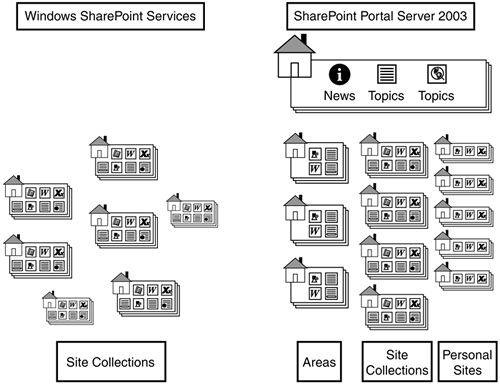Windows SharePoint Services Versus SharePoint Portal Server 2003
|
| The SharePoint family is composed of two products: Windows SharePoint Services and SharePoint Portal Server 2003. Windows SharePoint Services is the basic "engine" that provides document management and collaboration features, whereas SharePoint Portal Server 2003 adds additional portal functionality that is useful to larger organizations. Windows SharePoint Services is a free download that can be added to a Windows Server 2003 server, whereas SharePoint Portal Server 2003 must be purchased and licensed as a separate product. NOTE
Figure 1.1 provides an illustration of Windows SharePoint Services, as composed of a group of site collections of different sizes, and of SharePoint Portal Server 2003 consisting of areas, site collections, and personal sites. As this picture illustrates, the portal provides a number of different elements, in a structured fashion, whereas Windows SharePoint Services is limited to site collections. This being said, Windows SharePoint Services still offers a wealth of document management and collaboration features, and it's used by many organizations getting started on the knowledge management path. Figure 1.1. Windows SharePoint Services compared to SharePoint Portal Server 2003. You'll note in the image that each site collection in Windows SharePoint Services contains a house graphic, which represents the home page for that site collection, and several other icons representing the types of information that can be accessed from that home page. Documents that can be accessed from the home page include Microsoft documents (such as Project, Word, Excel, and PowerPoint documents), other non-Microsoft documents stored in document libraries (such a PDF files), as well as pictures (such as TIF, JPG, and GIF files), lists, and forms. These are typically made available through Web Parts, which will be discussed in more detail throughout the book. Other information, such as hyperlinks (or URL links), can be accessed from the site home page. What's more, other websites can be displayed in a window within the site. Suffice it to say at this point that a SharePoint site home page can provide access to a vast array of information. NOTE
There are also several pages shown for each site collection in the image, because a site can have subsites (some of which are called workspaces) beneath it. Although there is no real limit to how "deep" a site collection can go, in most environments the Site Administrators will strive to control the complexity of the overall structure, because navigating between the different sites can get confusing and increase the amount of time it takes users to find the information they are looking for. In this book we'll assume that the user is working with Windows SharePoint Services, so we'll concentrate on the features and functionality provided by Windows SharePoint Services. There may well be a SharePoint Portal Server 2003 environment configured above and beyond the Windows SharePoint Services sites, but don't worry because the skills you'll learn in this book will also apply to the portal. For example, the areas in a portal will contain lists and libraries that the site collections contain. Personal sites on the portal also contain the same lists and document libraries and can be customized in the same way they can in Windows SharePoint Services sites. So once you have worked through the lessons in this book, you will be comfortable with portal areas and personal sites as well. Portals are created by organizations with more extensive document management and collaboration needs, by organizations that want the added features of areas and personal sites (as well as enhanced search capabilities), and for access to some of the additional high-end features that SharePoint Portal Server 2003 offers. These include the ability to create multiple portals (some for internal use, and perhaps some for external customers to use) and link them together, and the ability to offer single sign-on services (so a user can access a number of business applications with one login). SharePoint Portal Server 2003 also offers enhanced management tools designed to handle very large and complex structures with hundreds or even thousands of sites and site collections. |
|
EAN: N/A
Pages: 181